Knee pain can be a frustrating obstacle, whether it's from arthritis, an old injury, or daily stress. The good news is that a gentle, mindful yoga practice has been proven to help. By strengthening the muscles that support the knee, you can improve mobility, reduce chronic pain, and enhance your overall quality of life.
This guide will walk you through safe and effective yoga poses designed to stabilize the knee joint by targeting the quadriceps, hamstrings, and glutes. With slow, controlled movements, you can gently stretch and strengthen the area without causing further harm.
What's in this Guide:
Why Yoga is So Effective for Knee Pain
Often, the source of knee pain isn't the joint itself, but an imbalance in the muscles surrounding it. Weak quadriceps, tight hamstrings, or stiff hips can all put unnatural stress on the knees. Yoga helps by:
- Strengthening Supporting Muscles: Poses like Chair and Warrior I build strength in the knee flexors (hamstrings), extensors (quadriceps), and hip extensors (glutes), which stabilizes the joint.
- Improving Flexibility: Gentle stretches for the hips and inner thighs, like Bound Angle Pose, can relieve tension that pulls on the knee.
- Correcting Posture: By improving overall alignment, yoga helps distribute your body weight more evenly, taking pressure off your knees during daily activities.
6 Safe Yoga Poses for Knee Relief
Remember to move slowly and listen to your body. Never push through sharp pain.
1. Chair Pose (Utkatasana)

This pose is excellent for developing strong thigh muscles, which act as primary support for your knees.
- How to do it: Stand with your feet together or hip-width apart. Inhale and raise your arms straight up. Exhale and bend your knees, sitting back as if you're sitting in a chair. Squeeze your thighs together and keep your weight in your heels.
- Beginner's Tip: Start with your feet hip-width apart for more stability. Don't sit too low; only go as deep as you can without pain.
2. Triangle Pose (Trikonasana)

Triangle pose works the inner quad and thighs while promoting stability through both legs.
- How to do it: Step your feet wide apart. Turn your right foot out 90 degrees. Extend your arms parallel to the floor. Hinge at your right hip, reaching forward before bringing your right hand down to your shin, ankle, or a block. Extend your left arm to the ceiling.
- Safety Note: Avoid hyperextending or "locking" your front knee. Keep a tiny microbend in the knee to engage your quadriceps for support.
3. Warrior I (Virabhadrasana I)
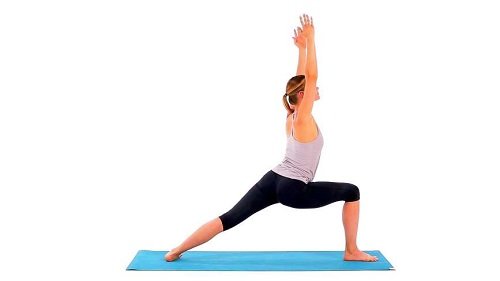
When done with proper alignment, this pose strengthens the muscles surrounding the knee and improves your overall balance.
- How to do it: From a standing position, step your left foot back, angling the toes slightly out. Bend your front (right) knee to 90 degrees, ensuring it is stacked directly over your ankle. Keep your back leg straight and heel grounded. Inhale and raise your arms overhead.
4. Tree Pose (Vrksasana)
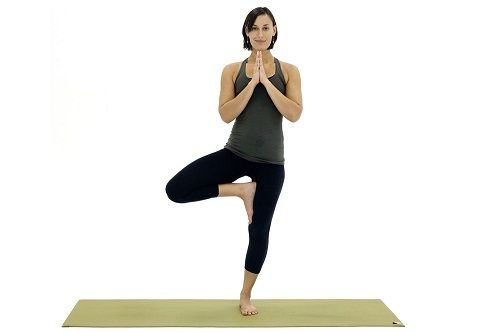
This balancing pose strengthens the outer hips and ankles, which contributes to knee stability.
- How to do it: Stand tall and shift your weight onto your left foot. Place the sole of your right foot on your inner left thigh or calf. Avoid placing your foot directly on your knee joint. Bring your hands to a prayer position at your chest.
- Beginner's Tip: Stand near a wall for support. Keeping your foot on your calf is a great modification.
5. Bound Angle Pose (Baddha Konasana)
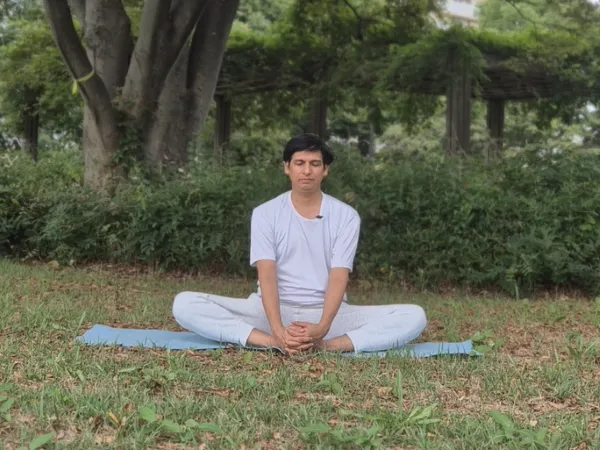
This seated pose opens the hip flexors and inner thighs, which can relieve tension that affects the knees.
- How to do it: Sit on the floor and bring the soles of your feet together, letting your knees drop out to the sides. Hold onto your feet and sit up tall. To deepen the stretch, you can gently fold forward.
- Safety Note: If you have any groin or knee discomfort, place folded blankets or blocks under your outer thighs for support.
6. Bridge Pose (Setu Bandhasana)
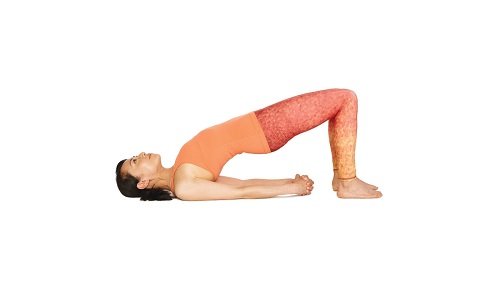
Bridge Pose aligns your knees while strengthening your glutes and hamstrings—key muscles for knee support.
- How to do it: Lie on your back with your knees bent and feet flat on the floor, hip-width apart. On an inhale, press through your feet to lift your hips off the floor. Keep your thighs parallel. Interlace your fingers underneath your body and press your arms down to help lift your chest.
Keep Your Knees Safe with Props
Props are your best friends when practicing with sensitive knees. They make poses more accessible and comfortable.
- Thicker Mat or Cushion: Always use a good quality mat. Adding extra padding under your knees for kneeling poses is essential.
- Blankets: Place a folded blanket under your hips in poses like Bound Angle Pose to reduce strain. In Hero Pose (Virasana), a blanket under your buttocks can relieve discomfort.
- Blocks: Use blocks under your hands in poses like Triangle Pose to bring the floor closer to you, preventing you from overstretching or straining the knee.
Watch: Guided Practice for Knee Safety
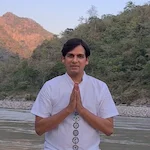
About the Author: Yogi Sandeep
Born in Rishikesh into a traditional family where the Vedic tradition has been a way of life for generations, Yogi Sandeep is the founder of Raj Yoga Rishikesh. He is an E-RYT 500 Teacher, holds a Master's degree in Yoga, and has over a decade of teaching experience.
Knee Pain & Yoga FAQs
Can yoga make knee pain worse?
Yes, if practiced incorrectly. Pushing too hard, improper alignment (like letting the knee go past the ankle in lunges), or doing poses that cause sharp pain can worsen an injury. Always listen to your body and modify poses as needed.
What yoga poses should I avoid with bad knees?
Generally, you should be cautious with or avoid deep, unsupported knee bends like Lotus Pose (Padmasana) and Hero Pose (Virasana) without props. Full squats and poses that put direct pressure or twisting force on the knee should also be approached with extreme care or avoided.
How often should I practice yoga for knee pain?
Consistency is more important than intensity. A gentle 20-30 minute practice, 3-4 times a week, can be highly effective. It's better than one aggressive session that leaves you sore.
Ready to Practice Safely and Effectively?
Learning correct alignment is the key to a safe and healing yoga practice. Gain the knowledge and confidence to guide yourself and others in our 200-Hour Yoga Teacher Training.
Learn About Our Training →
